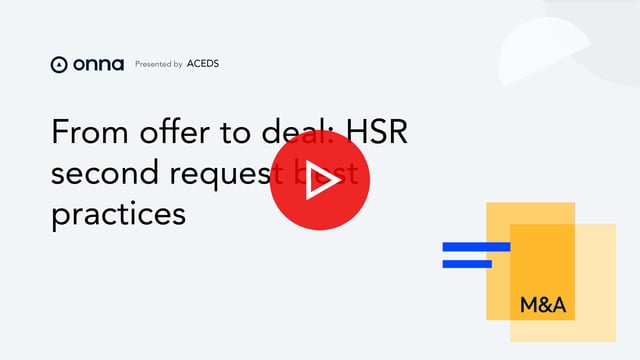Understanding HSR second requests

The M&A market had a record-breaking year in 2021 with more than $5 trillion in global volume. High private equity activity, a soaring stock market, and low-interest rates contributed to an exceptionally busy landscape, which experts expect to continue throughout 2022.
If you’re a law firm that regularly deals with HSR second requests, or a company preparing for a merger or acquisition, it’s crucial to stay on top of trends as the likelihood of receiving a second request remains high in today’s increasingly rigid regulatory landscape.
What is the HSR Act?
The Hart–Scott–Rodino Antitrust Improvements Act of 1976, commonly referred to as the HSR Act, is a set of amendments to the antitrust laws of the United States that require companies to file premerger notifications with the Federal Trade Commission (FTC) and the Antitrust Division of the Justice Department (DOJ) for certain acquisitions before consummation.
Under the HSR Act, companies undergoing transactions above certain thresholds must provide the agencies with 30 days to pursue an initial investigation to determine that the transaction will not adversely affect U.S. commerce under antitrust laws. During the 30-day waiting period, the FTC or DOJ may seek further information to determine the legality of the transaction. This is where second requests come in.
What is an HSR second request?
An HSR second request allows the FTC and DOJ to extend their merger review and ask the parties to submit more information to determine how the transaction will affect market competition. A second request stops the initial 30-day waiting period and grants the agencies a second waiting period, typically an additional 30 days. This prevents merging parties from consummating a transaction until the companies have substantially complied with the additional investigatory request (referred to as “substantial compliance”).
Recent changes to the second request review process
Mergers filed with the FTC and DOJ have doubled from 2010 to 2020, amounting to nearly 2,000 deals a year. And while 2020 saw a downward trend in M&A activity due to the worldwide economic shutdown caused by the COVID-19 pandemic, a resurgence emerged in 2021, hitting a record high of 4,130 merger notifications — up 155% over the 20-year average of 2001-2020.
Low full-time employee headcount, stagnant funding, declining resources, and a (tidal) wave in M&A HSR filings have taxed federal antitrust agencies. According to the FTC, this resource strain is “complicating the agencies’ effort to challenge all anti-competitive deals, resulting in concerning evidence of anticompetitive transactions that either were not challenged by the antitrust agencies or that were resolved through remedies that failed.”
To combat this, the Bureau of Competition announced a change to its second request process in September 2021. These changes include:
More comprehensive and analytically rigorous merger reviews to eliminate blind spots and disable unlawful consolidation.
Second requests now factor in additional aspects of market competition that may be impacted, such as how a proposed merger will affect labor markets, the cross-market effects of a transaction, and how the involvement of investment firms may affect market incentives to compete.
Requests for modification will only be considered after the companies under investigation have provided certain foundational information.
Aside from basic information about how companies maintain data that is responsive to specifications in the second request, companies must also “identify and describe the business responsibilities of employees and agents responsible for relevant lines of business, as well as those employees responsible for negotiating, analyzing, or recommending the transaction.”
Companies must provide information on the use of eDiscovery tools.
The FTC’s second requests now require each company under investigation to provide information about how it intends to use eDiscovery tools prior to applying those tools to identify responsive materials. This change more closely aligns the FTC’s model second request with that of the DOJ.
Discontinuing the option to submit a “partial privilege log.”
A privilege log is a running list of documents that are withheld as attorney-client privilege. A full privilege log is now required “to ensure that relevant information is withheld only on a well-grounded claim of legal privilege.”
Bureau staff must provide the full Commission with access to second requests and voluntary access letters.
This is done by uploading items into a secure system to maintain the confidentiality of documents.
How to prepare for a second request
Responding to an HSR second request presents significant challenges, including tight deadlines, strict production requirements, and the need to identify and collect vast amounts of electronic information all while maintaining high review accuracy. If your company is preparing for a merger or acquisition, waiting to receive a second request before planning to prepare for one is already too late.
Here are four considerations to keep in mind when it comes to second request productions.
Stay on top of trends affecting HSR second requests
It’s a good idea to keep track of how the regulatory agencies are evolving their approaches to handling second requests. For example, the FTC maintains a “Competition Matters” blog where they write about developments regarding second requests that can be useful in preparing for one.
Prepare and maintain a company data map
A data map is an accurate representation of a company’s data landscape that helps keep data more structured, cohesive, and accessible. Not only will having a data map save you time in responding to a second request, but the FTC’s model request specifically asks for a data map in the Request itself.
Start thinking about the second request before filing
When you’re in the early stages of discussion regarding a merger or acquisition, it’s important to keep in mind what might be subject to a second request, should one occur. While only 3% of HSR filings resulted in a second request for both 2019 and 2020, it’s important to get ahead while you can as more changes to the HSR Act are expected under the Biden Administration’s progressive approach to antitrust enforcement.
Centralize critical company information in a search-ready repository
With the accelerated time frame and comprehensive scope associated with second requests, there isn’t a lot of time to chase down key documents and other electronically stored information scattered across data sources. Having the ability to locate that essential information quickly within a searchable repository could expedite the second request response process considerably, not to mention the benefits it provides to support better decision-making, employee knowledge sharing, and policy compliance for your organization.
Stay up to date on HSR second requests
You can think of HSR second requests like other discovery projects, but with larger volumes of data, tighter deadlines, and more stringent production requirements. The good news? There are best practices you can implement to reduce the associated cost inefficiency (and headache) of second requests while ensuring an effective, accurate, and timely response.
 eDiscovery
eDiscovery Collections
Collections Processing
Processing Early Case Assessment
Early Case Assessment Information Governance
Information Governance Data Migration
Data Migration Data Archiving
Data Archiving Platform Services
Platform Services Connectors
Connectors Platform API
Platform API Pricing Plans
Pricing Plans Professional Services
Professional Services Technical Support
Technical Support Partnerships
Partnerships About us
About us Careers
Careers Newsroom
Newsroom Reveal
Reveal Logikcull by Reveal
Logikcull by Reveal Events
Events Webinars
Webinars OnnAcademy
OnnAcademy Blog
Blog Content Library
Content Library Trust Center
Trust Center Developer Hub
Developer Hub